If you follow me on Instagram, you will know that I have recently returned from… Japan.
Before I go into the details of the trip, let me tell you that visiting Japan has always been a dream of mine. You see, Italian children of my generation have grown up with bread and Nutella and Japanese anime. The same way American kids watch Sesame Street or Australian children follow Play School, Italian kids are immersed in the Japanese anime culture. This made my experience in Japan almost surreal: I felt completely at ease and things that would seem unusual to other foreigners (including my husband and children!), felt completely normal to me. In a way, it was like going back to a familiar place… where I spent my childhood. Besides, I was surrounded by icons from my childhood from Monchhichi to Doraemon to Hello Kitty!

That said, my family and I had already planned this same trip for April 2011. Unfortunately, we had to cancel it, as Japan was hit by a terrible earthquake and tsunami just 2 weeks before our scheduled departure.
This time, we decided to try again and to make Japan a sort of long stop over on our way to Italy. In fact, this is a great route to go from Australia to Europe… one that is less “popular” with travellers, but the one I prefer. It’s not longer than the usual Singapore/Hong Kong/Dubai one… and definitely a great opportunity to visit an amazing country!
Before going into more details about our journey, I think it would be useful to give you some practical information that will help you plan your own trip.
TYPES OF ACCOMMODATION
In Japan there is no lack of choice for accommodation. You can choose to stay in hostels, business hotels, upmarket hotels, Japanese Inns and even capsule hotels!
If you travel as a couple, you will be spoilt for choices. But, if like us, you are a family with young kids, then your best option is to book Japanese style rooms. Western style rooms are usually very small and it’s almost impossible to find a room with 4 beds! So, we stayed in ryokans (Japanese style hotels) and slept on futons on tatami mats. It is actually very comfortable! The rooms are often used as a “day room” during the day and then, at night, the futons are prepared for you to sleep on. This means that even smaller rooms have enough space to do everything you need.
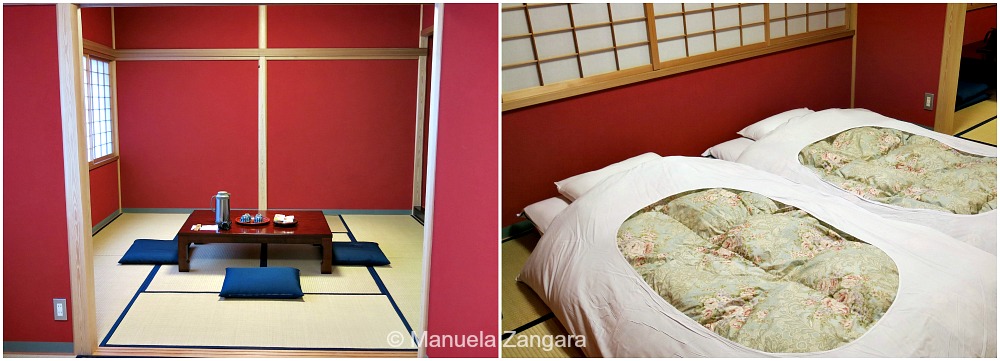
All the places we stayed in had a private bathroom with a Japanese style toilet… the one with many functions, including a washlet and heated seats!

And in a couple of places we even had a private onsen in the room!

HOTEL BOOKINGS
There are many sites where you can easily book your hotels in Japan, like Booking.com or HotelsCombined. I personally prefer to book directly with the hotels via email, but do shop around to see if you find better prices/offers.
If you are interested in booking a Japanese Inn (ryokan), I found this site very useful: Japanese Guest Houses I booked our stay in the temple in Koyasan and it was very easy and quick.
To decide on the hotels to book, I often read reviews on Tripadvisor and besides reading what other travellers have to say, I look at the pictures they took, as those don’t lie and I can get a better idea about the place. Always ensure that your booking can be cancelled any time before your stay, just in case… (been there, done that in 2011!).
MONEY
Credit cards are not as commonly used as in the USA or Australia, but we never had a problem paying for hotels with them.
We decided to get traveller’s cheques in Japanese Yen here in Australia and then we exchanged the full amount in Narita. At first we thought we would exchange them as required, but as Japan is a very safe country, we thought to do it all at once and don’t worry about finding a bank later on.
INTERNET
All the hotels we stayed in had free wi-fi. So, keep that in mind when you decide whether or not you need Internet 24/7. I wanted to share my experiences on the spot, so we decided to get a data SIM for my mobile. We also found it quite helpful to check train time tables and google maps, when needed.
For Internet you have a couple of options:
- Data SIM. This was our choice. We got a Docomo SIM (data only, which means you cannot make phone calls or send text messages from your mobile). It was 3GB and it lasted 1 month (they also had a 1GB per month plan). It cost 6,500 yen and even though we had some problems to activate it, it never gave us any issues for the whole trip and we always had a very good connection. We were also able to use my mobile as a hotspot for our other devices, so we were quite happy with this solution. Besides, we didn’t have to book this SIM and we didn’t even have to return it. Easy peasy.
- Pocket Wi-fi. There are many companies that rent pocket Wi-fi’s (one of them being Global Advanced Communications) with different plans and prices, many of which also provide free delivery and a return envelope so you can ask your hotel to send it off on your behalf. They may require a booking.
FOOD
A little note about food (I will get into all the details in my later posts). Usually, Japanese restaurants specialise in one kind of food (like sushi and sashimi, ramen, okomaniyaki etc.). This makes it a little hard for people with fussy kids… like us. If you cannot agree on what you want to eat, your best bet is to eat at izakayas, which are Japanese style pubs that serve little servings of different kinds of food. A little like Spanish tapas.
Food stalls are also a very good option and you can usually find them around big temples, parks and other tourist attractions.
JAPAN RAIL PASS
Also, if you are planning to travel around Japan, I highly recommend you use the JR rail pass. It’s valid for 7, 14 or 21 days and it’s really convenient. You basically purchase a voucher before travelling to Japan and then exchange the voucher for the real pass when you arrive. We got ours from JTB here in Sydney, but there are many agencies that sell them.
You can decide on which date you want it to begin and then you can travel on the JR lines as many times as you want during that period. This includes the Shinkansen trains! You may choose to reserve a seat at the JR counters or sit in the non-reserved cars. Not only, travelling by train in Japan is an experience on its own. When you reserve a seat, you get your seat number and car number printed on the ticket. The platform has got all the car numbers clearly marked on the ground, so you can go and queue in the right place. When the Shinkansen arrives, everyone is ready to board and it literally takes less that 5 minutes for the people to get down and board and for the train to move!!! Also, if you suffer from motion sickness, be aware that the Shinkansen feel like a plane… I know it! 😉

HOW TO PLAN YOUR ITINERAY
I have travelled quite a lot in my life and I never book tours from travel agencies. That’s because I love to be in control of my holiday and because, to me, planning is half the fun of the holiday itself! Japan is a destination that is easy to organise because there is a ton of information about it available on the web.
Here are the sites that I highly recommend you read when planning:
- TripAdvisor – to find hotel and restaurant ratings. There is also a great Japan forum with friendly people who give very good advice.
- Lonely Planet Thorntree – a good Japan forum.
- Japan Guide – a Japan specific website with info on places and attractions around Japan. They also have a forum with plenty of info.
- Travel blogs to read other people’s experiences (google them and you will be amazed by how many there are!).
- Find images of places/cities/attractions to see what they really look like and if you’d like to see them.
- Hyperdia – the site to check train/subway/shinkansen schedules around Japan. This is useful both while planning the trip and when you are in Japan!
- Google Maps – useful for planning, but above all while in Japan. We used the navigator part quite a bit to get from one place to the other on foot. So much easier than having to deal with a map (often not in scale), especially where there are no street names!
I also have a Lonely Planet Japan (Travel Guide) that I find very useful.
OUR JOURNEY
We kept most of the journey the same as originally planned, but we decided to skip Hakone, Kamakura and Nikko to make up for a couple of days that we had to cut off from our stay. We planned everything well ahead of time… we were going in peak season (the cherry blossom season!) and we didn’t want any bad surprises. We started to book our accommodation about 10 months before travelling and we already had some issues finding a room (we needed a room for 4!) in a couple of places. I guess what I am saying is… don’t leave it too late.
So, on the 1st of April, we flew Qantas from Sydney to Tokyo. I love that this is a night flight. It departs at 10:30PM and you get to Narita at 6:30AM! My kids were so exhausted after the day in school, that they slept well and I managed to get some sleep too. This helped a lot to start our journey straight away the next day!
When we arrived, we decided to take care of a few things right there in Narita: exchange all our traveller’s cheques, get a local SIM with Internet data, get a SUICA card, exchange our Japan Rail Pass vouchers to get the passes and book a few train journeys for the days ahead! Yeah, I know… a lot of stuff after a 9 hour flight, but people in Narita speak English and we didn’t want to waste time looking for the right places after arriving in Tokyo.
Narita is an amazing airport… very easy to navigate… but if you have a problem, you can always ask the information desk. We managed to exchange our money without any problems and we then went down to the underground level to purchase a Docomo SIM for our mobile. The service was reliable and fast… no issues! The only annoying thing was that it took over 1 hour for it to start working… and we had to wait at the shop, just in case… So, that was a waste of time… and we got delayed… and, by the time we got to go get our JR passes, the queue was really long. Anyhow, we got through and we also managed to get our SUICA cards (the rechargeable JR/Subway cards that are very useful in Tokyo, but also in other cities) and to book a couple of train journeys (they wouldn’t book more than 2 days’ journeys in that specific office, to save time so that the queues don’t get too long). So we booked the rest of the tickets in Hiroshima.
To get to our ryokan in Asakusa, we took a train… but, by mistake, we took a local train… and it took ages!! When we finally arrived in Asakusa, we went straight to our ryokan: Ryokan Kamogawa, where we left our luggage and then we went out to eat in a local izakaya.

When we went back to our ryokan, my husband rested (he had a terrible sinus attack!), while I repacked and got our luggage ready to be shipped to Kyoto. In fact, there is a fantastic service in Japan that can be very useful when you travel to different destinations: it’s called takuhaibin and it’s a delivery service. You basically ask your hotel to organise this and your luggage gets shipped to whichever address you want (just have the address written in Japanese to make things easier). It is quite cheap (around 15$ per suitcase) and so convenient! When you get to your destination, you find your bags waiting for you!
After that we visited the Sensoji temple and Nakamise Dori, a beautiful area… especially with the cherry blossoms being in full bloom!
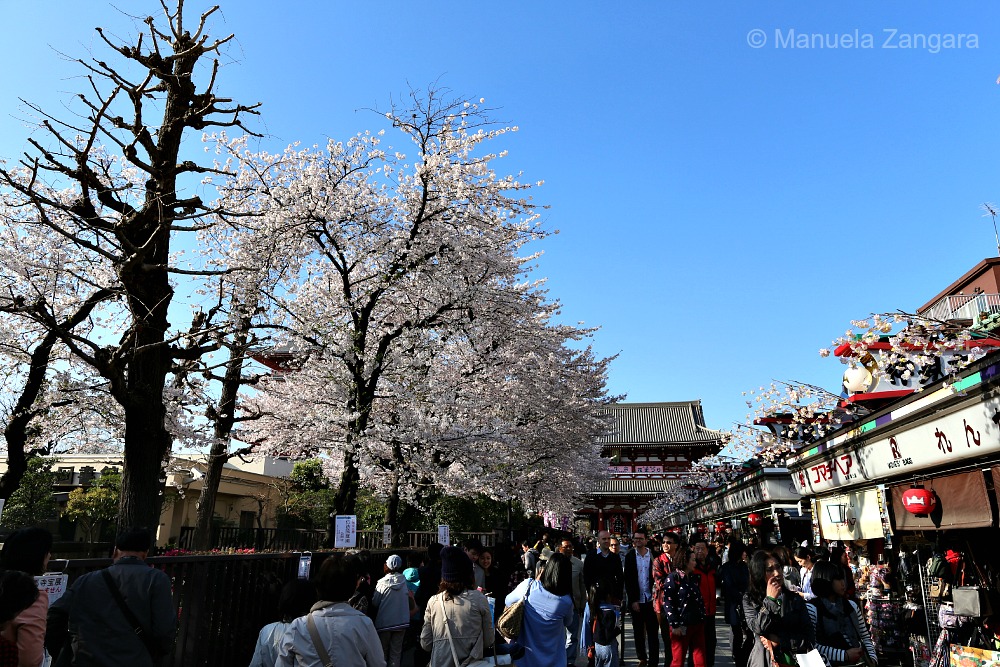
We also went back in the evening to enjoy the magic atmosphere and some delicious street food.
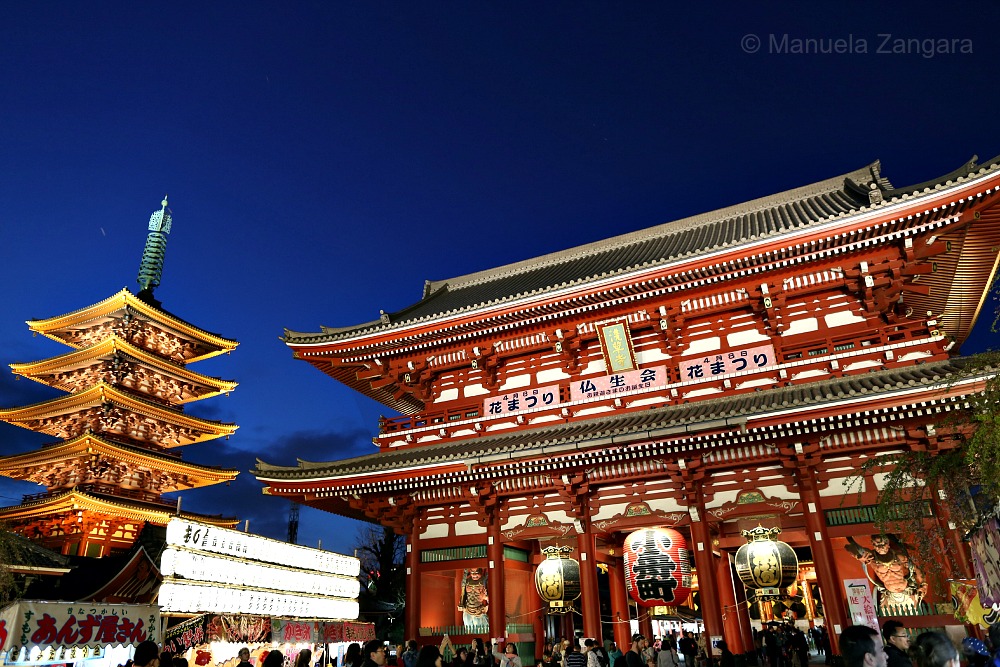
I will write a little guide on what to see/do/eat in Asakusa in the next few days, so stay tuned.
The following day (3rd of April), we left early for Miyajima. It is a very long trip from Tokyo… we first took a Shinkansen to Shin-Osaka, then we changed and took another Shinkansen to Hiroshima. That’s about 2.5+1.5 hours on the train (waiting time not included). Once in Hiroshima, we took a local train to Miyajimaguchi (30 minutes) and then a ferry that took us to the island of Miyajima in 10 minutes. We arrived in the afternoon… and the people from Auberge Watanabe, the Japanese Inn where we were staying, came to pick us up at the peer.
I will write more about Miyajima and our experience at Auberge Watanabe (where we also had an amazing keiseki dinner) in a specific post, but let me just tell you that we loved it! Unfortunately it was raining all the time, but the place was still magic. The Itsukushime shrine and the floating Tori were breathtaking! This is a place I would love to come back to again!

After the delicious keiseki dinner, we went out to see the sights all lit up… so beautiful!
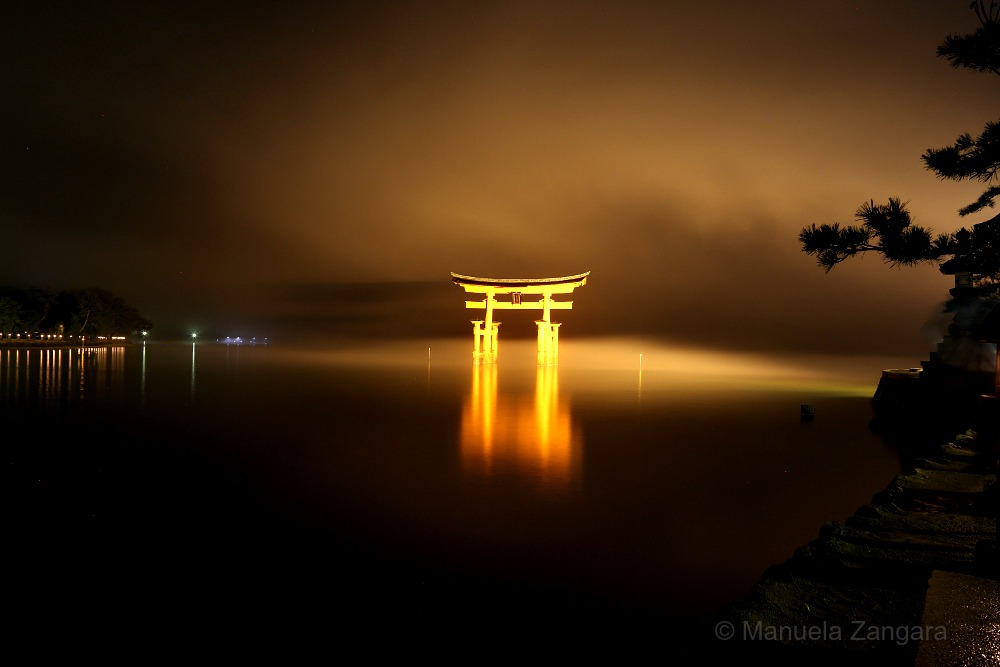
Unfortunately, the next morning we had to leave early, as we had planned to go visit the Hiroshima Peace Memorial Park and Museum before heading to Osaka. Hiroshima is a very modern and beautiful city, and despite being sadly famous for being the victim of the atomic bomb is very vibrant. I thought it would be sombre, but it’s a happy city full of life.

The Museum was very touching and I will have a special section about Hiroshima and what to see there.

We were supposed to stop in Himeji on our way to Osaka, to visit the famous castle… but the rain and some fatigue got the better of us and we decided to skip the castle. In Osaka we stayed at the Dotonbori hotel in Dotonbori, the modern area of town.

We were very pleasantly surprised by Osaka. We had included it in our trip mainly as a night stop between Hiroshima and Koyasan, but it would definitely deserve a few days of its own! We loved all the lights in Dotonbori… very “Blade Runner” style.

We had a “yakitori dinner” in an izakaya and went to sleep… exhausted.
The 4th of April we took a train from Osaka’s Namba station to Koyasan, a little town on top of a mountain filled with temples. We actually took a train, a cablecar and a bus to get to the town centre! It took about 2.5 hours, but it was fun and we enjoyed the view. We passed from some beautiful valleys with lots of cherry blossoms… <3

The characteristic of Koyasan is the fact that you get to sleep in a temple. We chose Shojoshin-in, for 2 reasons: it was very close to the Okunoin cemetery (the main reason why we visited Koyasan) and it had a hanare/little house, which was separate from the temple with a private bath.
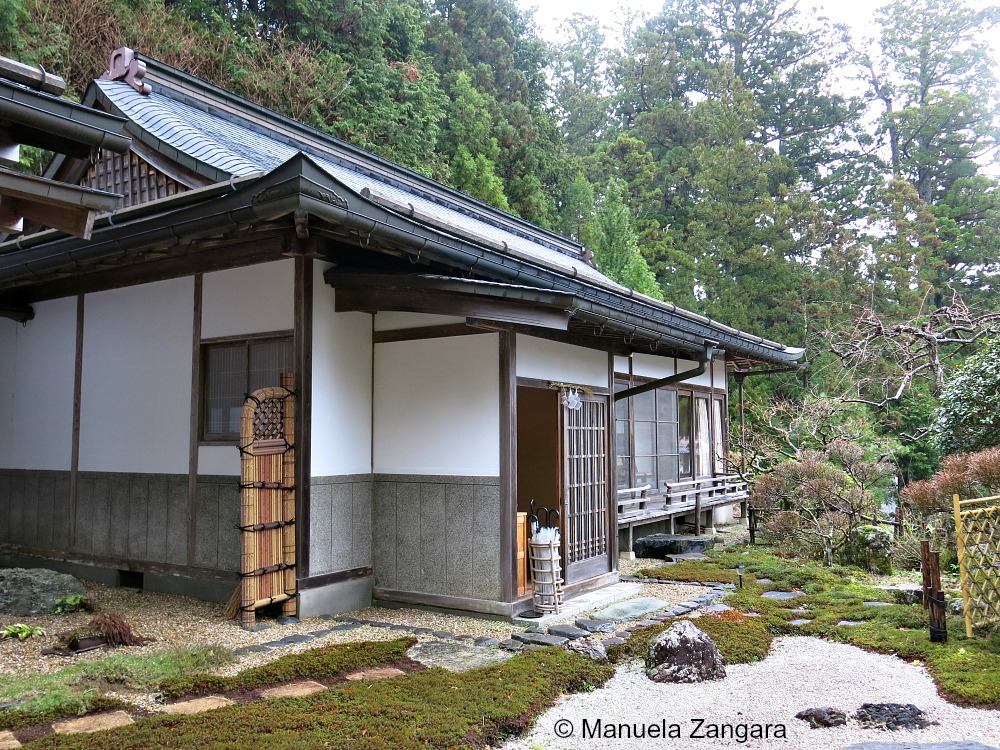
The majority of the temples in fact, have rooms only with shared bathrooms, not the best option when you have small children. Besides, it’s good for the kids to have some space, so they can unwind without disrupting the quiet life of a temple… Koyasan is also famous for its food and the shojin ryori cuisine (also known as Buddhist/vegetarian cuisine) that is served in the temples. I will give you all the details of our experience in Koyasan later on, but we really liked the visit to Okunoin, even though… you guessed it… it was raining!

The next day, 5th of April, we visited some of Koysan’s temples and then we went to Kyoto (via Osaka). Oh, Kyoto! I absolutely fell in love with the city. I was a bit worried about our stay, as I had heard so much about it that I was afraid my expectations would not be met. If anything, I liked it even more than I thought I would! And, believe me, I cannot wait to be back! I am going to write a separate guide on Kyoto, as we were there for 6 nights and I have a lot to write about it!
We rented a little machiya (Japanese town house) in the heart of Higashiyama, near the Kiyomizu dera and I am sure that it contributed a lot to my love for this city!

Having a house is not like having a room in a hotel… you get to live like a local and we thoroughly enjoyed it. Don’t worry, I will give you all the details later on in my Kyoto guide!
We spent 6 unforgettable days in Kyoto… and still we didn’t get to see and do all the things we had planned to. We obviously visited some of the famous temples/monuments like Kiyomizu dera, Yasaka jinja, Ginkakuji, Kinkakuji, Nijo-jo, Nanzenji, Ryoanji, Nishiki market, the bamboo forest etc. We even spent one afternoon doing a wonderful cooking class (Haru Cooking Class).

We got to see a few geishas in Gion… and they do walk very fast!
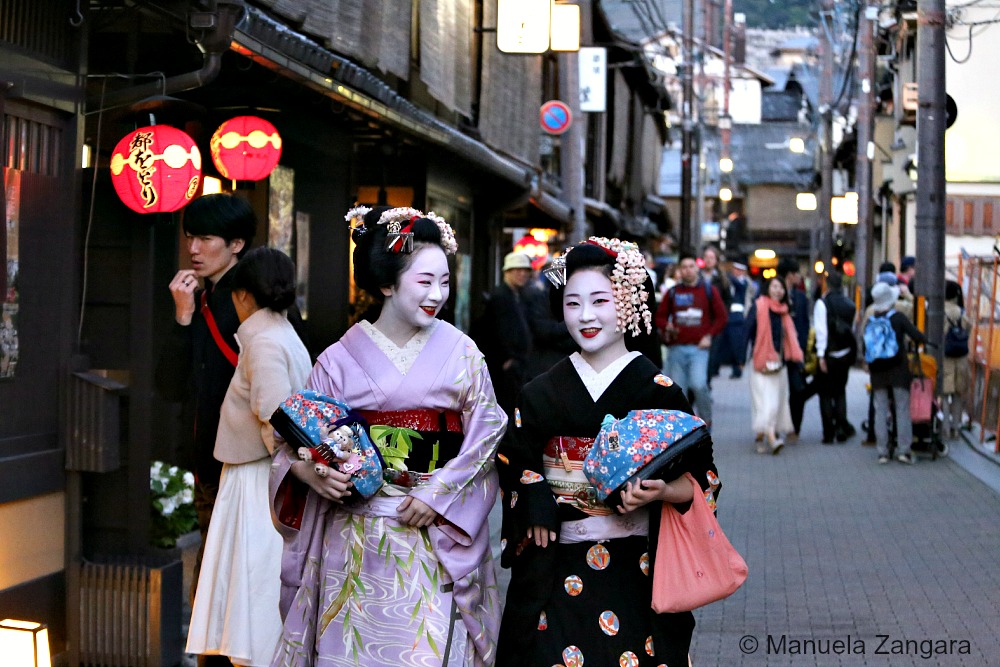
For lunch we would eat street food (beef steamed buns, chicken karaage, yakitori etc.) and for dinner we would visit the depachikas (food “boutiques” inside the big department stores) and buy anything from gyoza to tempura, sushi and sashimi and take it back home to enjoy it in the warmth of our kitchen!

While staying in Kyoto, we took a day trip to Nara to see the Todaiji temple and the Daibutsu.

Impressive! We also saw other beautiful temples in Nara, but as it was raining heavily, I personally didn’t enjoy it as much as I could have. On our way back to Kyoto, we stopped at Fushimi Inari to visit the shrine… the sun came out and it was amazing! Possibly my personal favourite site! If you have seen the movie “Memoirs of a Geisha” you will know what shrine I am talking about… for the rest of you, you basically have to pass through hundreds of orange toris to get to the top of the hill where the temple is. The toris are just breathtaking when the sun reflects on them… look at that orange, it’s like fire!

Leaving Kyoto was very hard… I did leave a piece of my heart back there and I have promised myself that I will do my best to go back one day.
On the 12th of April, we left for Kanazawa. I was so sad about leaving Kyoto that I thought I wouldn’t like it… it’s hard to come right after Kyoto. Instead, Kanazawa is actually very beautiful and I loved it! We stayed in a very nice ryokan called Sumiyoshiya. We visited the Higashi Chaya district, full of tea houses

and the Samurai district.

We also went to the magnificent Kenrokuen garden. It was an amazing sight, as the cherry blossoms were at their peak (unlike in Kyoto where we missed the peak for a few days!).
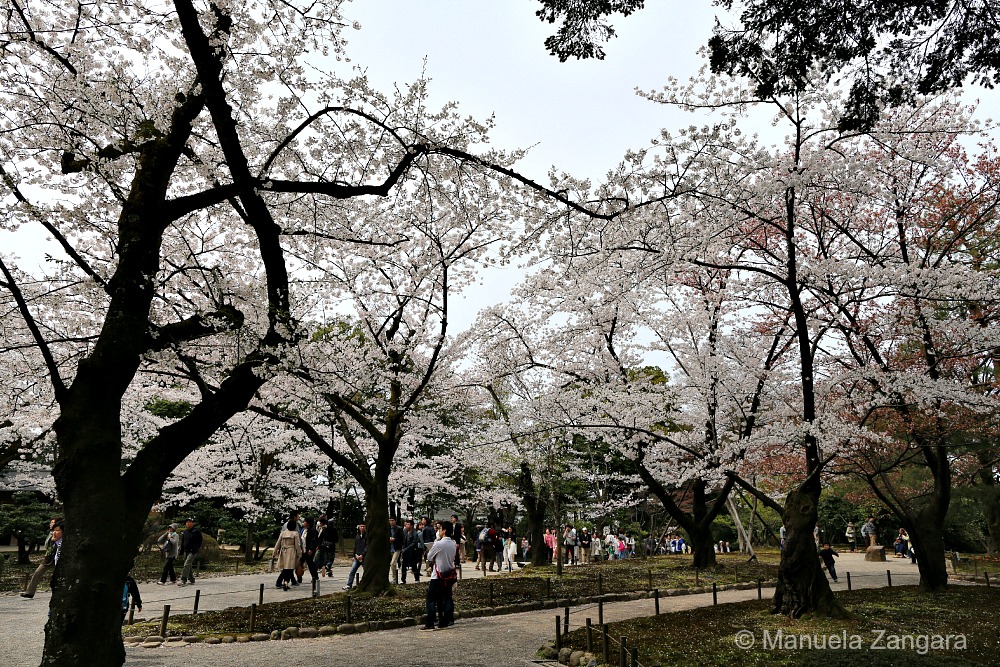
There were hundreds of locals enjoying the sakura and doing hanami/picnics under the flowers. It was just so pretty! We also visited the Ninja-dera and the Omicho market, where we had sushi that was easily just as good as the sushi we had at Tsukiji market in Tokyo (at almost half the price!). More details will follow!

Our next destination was Takayama, where we stayed 2 nights (13th and 14th of April). We had planned to visit just in time for the famous Spring Festival… only, we weren’t that lucky. It was raining the whole time we were there, so part of the festival was cancelled. Anyhow, the town is very nice!

We also got to eat the amazing Hida beef (not that different from Kobe beef).

Also, the train journey to get there is spectacular! You pass through the Japanese Alps… and it really looks like THE Alps I know: rivers, forests, valleys and even… snow! We stayed at ryokan Asunaro… just perfect! More about it in my write up on Takayama!
After Takayama, we returned to Tokyo, where we spent 2 nights in Annex Katsutaro, in Yanaka. Yanaka is a nice, quiet area of Tokyo, near Nippori station. I personally liked both the ryokan and the area, as there is a little market/shopping street just around the corner.

The only thing I didn’t like too much was the fact that there were not many options for dinner. There are a few places, but not too much choice. Location-wise though it was very convenient as we were travelling to and from Narita airport, which is connected via the Keisei Skyliner to Nippori station… in just 35 minutes! And, Nippori is on the Yamanote line, which is covered by the JR pass. Also, we had a HUGE bathroom… compared to the tiny micro bathroom we had in Asakusa. Probably though, the next time, I’d choose Asakusa again, as I fell in love with the Sensoji area! 😉
We visited Yanaka, which is nice and has a very interesting cemetery… with the tomb of the last Shogun! We also went to the fish market (Tsukiji) and I will have a separate post for this as it was quite interesting.

Ueno park was nice too, but unfortunately the cherry blossoms were already over. The last place we visited was Akihabara, which was nice too, but we could not stay long enough to see it by night: we had to go back and pack our stuff!

The next morning we left for Italy!
~*~*~*~*~*~*~*~*~*~*~*~*~*~*~*~*~*~*~*~*~*~*~*~*~*~*~*~*~*~*~*~*~*~*~*~*~*~*~*~*~*~*~*~*~*~*~*~*~*~*~*~*~*~*~*~*~*~*~
On our way back from Italy, in mid-May, we stopped in Tokyo again for 2 nights (and 3 days). We stayed at Annex Katsutaro, in Yanaka again as it was convenient from the airport. This time we left our luggage at Narita (it’s about 5$ per suitcase, per day) and we travelled with just our hand luggage.
The first day we were really jet lagged, but we tried not to sleep during the day… so we spent it in Asakusa: we wanted to buy a tamagoyaki pan in Kappabashi, the area where you can find everything for your kitchen! Unfortunately, as I was very jet lagged, the tamagoyaki pan was the only thing I bought… and I am still kicking myself as I now know I really need at least 2 extra items: a ginger grater and a Japanese plate! Grrrrrr
Anyhow, we were also lucky enough to experience a bit of the Sanja Matsuri (the Asakusa festival) and we got a glimpse of the floats being carried around, which was nice.

We also went back to the Sensoji and Nakamise dori and we went to have dinner at the same izakaya where we had eaten on the first day… the food was still delicious. We didn’t order too much though, as we wanted to have some more chicken karaage from a stall near the Sensoji… the best karaage we had in our whole trip (and we had quite a bit!).

The following day we woke up very late (thank you jet lag!)… Anyhow, we still got to see the Sony building, the Imperial Palace area, Tokyo station and then Shinjuku. I actually liked Shinjuku… we visited electric town (denki gai) – very similar to Akihabara, Kabuki-cho and Golden gai, which I loved. Golden gai is an area full of tiny izakaya/bars and when I say tiny, I mean just-enough-to-sit-about-5-people-tiny! Lovely!!
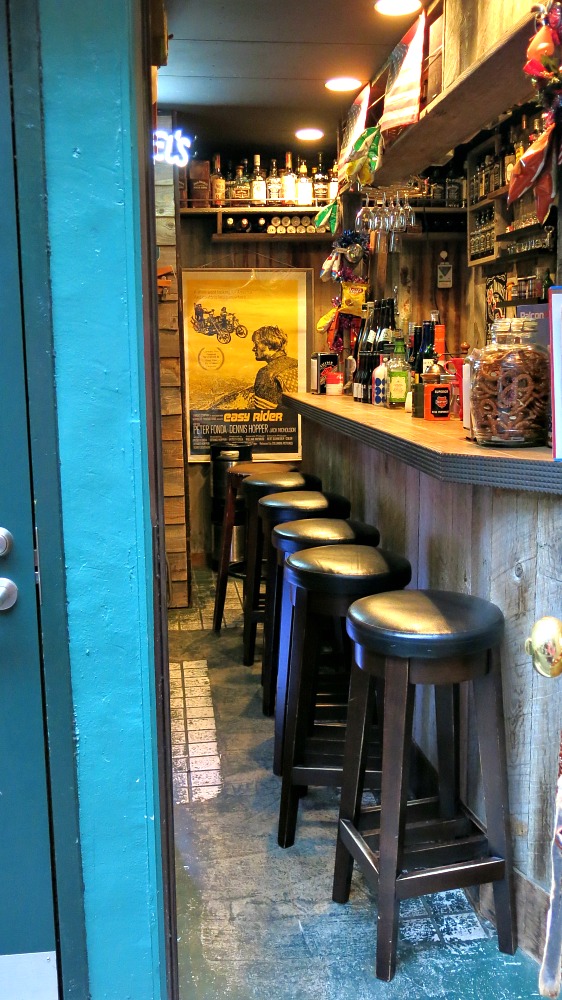
Unfortunately it was too early to eat… so we kept on walking around until after sunset, when we finally got to see the famous Shinjuku lights: beautiful!

And there’s also a depachika at the local Takashimaya, which is just as good as the one in Kyoto! Shinjuku is actually a good area to stay… lots of hotels and restaurants, so if you are a couple, I’d recommend it.
On our last day, we were not too lucky. It was a beautiful sunny day (finally), but it was unbelievably hot and humid (in May!). We started off well and went straight to Shibuya to see the Hachiko statute

and the huge pedestrian crossing.
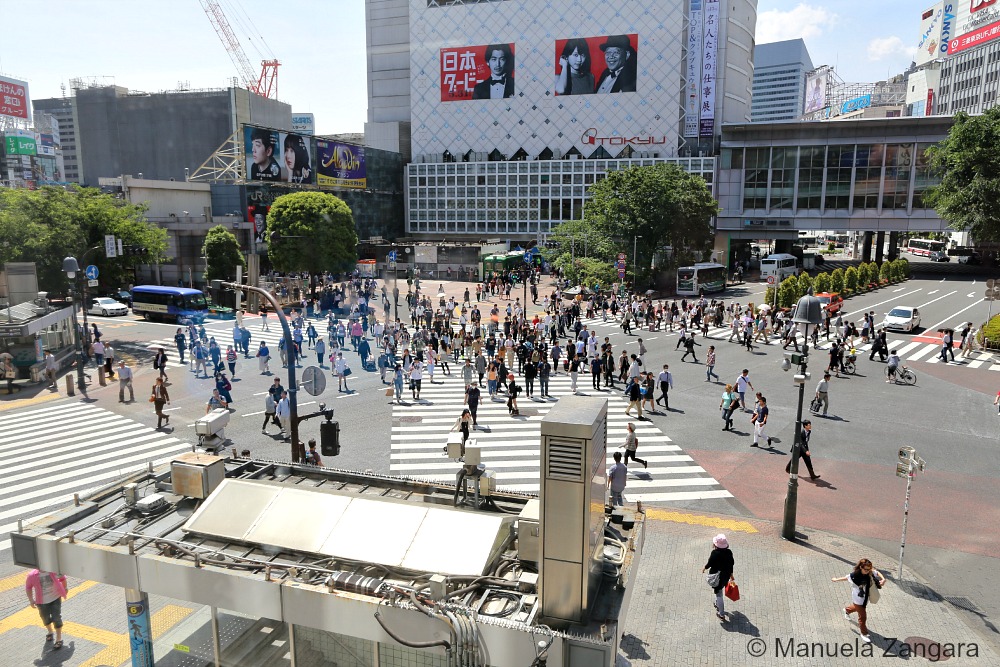
We then went back to Shinjuku to see the panorama from the Tokyo Metropolitan Building (which was closed the previous day)…

Then our luck stopped. Firstly we got lost in Shinjuku station trying to get to Takashimaya for lunch… Then, when we got to our next destination, Harajuku, we got completely stuck in the crowd inside the train station. It was crazy!! We got down from the train and it took almost 15 minutes to get out of the station… I was afraid we would be crushed, but luckily Japanese people are very calm and I guess they know how to deal with crowds. We went to the Meiji shrine, but we had to skip Takeshita dori as the crowds were unbelievable and we were afraid we would get stuck and miss our evening flight. So, we will have to go back to Tokyo to see it… 😉

Despite the crowds we managed to go back to the hotel to pick up our hand luggage and go to Narita in time for our night flight back to Sydney.
Needless to say, we loved Japan. Every single place we saw was amazing. The people are very kind and friendly and the food is to die for. I will never be able to enjoy “Australian sushi” again, after having sushi in Japan, that’s for sure! But I have also discovered other fantastic dishes that I will try and replicate at home, so stay tuned for the recipes! This is a trip I highly recommend!
I often fall in love with the places I visit and I often say “I will go back soon”… but this time it’s different. This time I KNOW I will go back!! 🙂
OUR ITINERARY
So… this was our itinerary, perfect for a first trip to Japan:
02/04/2015 Tokyo (arrived in the morning)
03/04/2015 Tokyo – Miyajima
04/04/2015 Miyajima – Hiroshima – Osaka
05/04/2015 Osaka – Koyasan
06/04/2015 Koyasan – Kyoto
07/04/2015 Kyoto
08/04/2015 Kyoto – Nara – Kyoto
09/04/2015 Kyoto
10/04/2015 Kyoto
11/04/2015 Kyoto
12/04/2015 Kyoto – Kanazawa
13/04/2015 Kanazawa – Takayama
14/04/2015 Takayama
15/04/2015 Takayama – Tokyo
16/04/2015 Tokyo
17/04/2015 Tokyo – Italy
15/05/2015 Tokyo (arrived in the morning)
16/05/2015 Tokyo
17/05/2015 Tokyo – Sydney (night flight)
If you have any questions, leave a comment and I will be happy to help out!
RESOURCES ON MSM
RECIPES:
TRAVEL IN JAPAN:
Nara & Fushimi Inari guide – Japan
Haru Cooking Class Kyoto – Japan Guide
*In the spirit of full disclosure, this post contains some affiliate links, which means that I may get a commission if you decide to purchase anything from my partners’ sites.




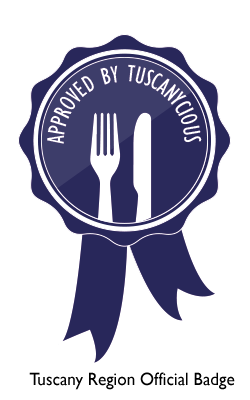













Oh Manu, I’m feeling terribly homesick for Japan after reading this gorgeous post and looking at your stunning photos. I seriously cannot wait to go back. What fabulous memories you and your family created. Something you guys will remember always I’m sure.
Hello,
Great blog, thanks for all the info about Japan.
Do you think mid April will be good time to visit?
And another question- what do you think (very roughly) is the budget need for family with 2 kids? daily budget or any frame you can think off….
Best Regards,
Itai